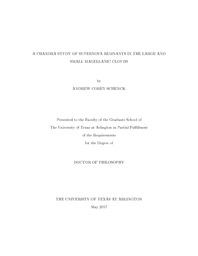
ATTENTION: The works hosted here are being migrated to a new repository that will consolidate resources, improve discoverability, and better show UTA's research impact on the global community. We will update authors as the migration progresses. Please see MavMatrix for more information.
Show simple item record
| dc.contributor.advisor | Park, Sangwook | |
| dc.creator | Schenck, Andrew Corey | |
| dc.date.accessioned | 2017-07-03T14:52:05Z | |
| dc.date.available | 2017-07-03T14:52:05Z | |
| dc.date.created | 2017-05 | |
| dc.date.issued | 2017-05-04 | |
| dc.date.submitted | May 2017 | |
| dc.identifier.uri | http://hdl.handle.net/10106/26791 | |
| dc.description.abstract | In the first part of this thesis we measure the interstellar abundances for the elements O, Ne, Mg, Si, and Fe in the Large Magellanic Cloud (LMC), based on the observational data of sixteen supernova remnants (SNRs) in the LMC as available in the public archive of the Chandra X-ray Observatory ( Chandra). We find lower abundances than previous measurements based on a similar method using data obtained with the Advanced Satellite for Astrophysics and Cosmology( ASCA). We discuss the origins of the discrepancy between our Chandra and the previous ASCA measurements. We conclude that our measurements are generally more reliable than the ASCA results thanks to the high-resolution imaging spectroscopy with our Chandra data, although there remain some systematic uncertainties due to the use of different spectral modelings between the previous work and ours. We also discuss our results in comparison with the LMC abundance measurements based on optical observations of stars.
The second part of this thesis is a detailed study of a core-collapse SNR B0049--73.6 in the Small Magellanic Cloud (SMC). Based on our deep Chandra observation, we detect metal-rich ejecta features extending out to the outermost boundary of B0049-–73.6, which were not seen in the previous data. We find that the central nebula is dominated by emission from reverse-shocked ejecta material enriched in O, Ne, Mg, and Si. O-rich ejecta distribution is relatively smooth throughout the central nebula. In contrast the Si-rich material is highly structured. These results suggest that B0049-–73.6 was produced by an asymmetric core-collapse explosion of a massive star. The estimated abundance ratios among these ejecta elements are in plausible agreement with the nucleosynthesis products from the explosion of a 13–-15M_sol progenitor. We reveal that the central ring-like (in projection) ejecta nebula extends to ~9 pc from the SNR center. This suggests that the contact discontinuity (CD) may be located at a further distance from the SNR center than the previous estimate (~6 pc). Based on our estimated larger size of the CD, we suggest that the significant effect from the presence of a Fe-Ni bubble at the SNR center (as proposed by the previous work) may not be required to describe the overall dynamics of this SNR. Applying the Sedov-Taylor similarity solutions, we estimate the dynamical age of $\sim$17,000 yr and an explosion energy of E_0 ~ 1.7 X 10^51 erg for B0049-–73.6. We place a stringent upper limit of L_X ~ 6.0 \times 10^32 erg s^-1 on the 0.3-7.0 keV band luminosity for the embedded compact stellar remnant at the center of B0049-–73.6. Our tight estimate for the X-ray luminosity upper limit suggests that the compact stellar remnant of this SNR may be a similar object to those in a peculiar class of low-luminosity neutron stars (e.g., the so-called Dim Isolated neutron stars) or may possibly be a black hole.
Finally, we demonstrate our adaptive mesh grid method for the analysis of the rich SNR data. We developed our own computer software to implement this technique which is useful for an efficient spatially-resolved spectroscopic study of high-quality datasets of SNRs. As part of this software we also implement automated spectral model fits for all individual spectra extracted from our adaptively defined small sub-regions. We illustrate the utility of this technique with an example study of SNR N63A in the LMC. | |
| dc.format.mimetype | application/pdf | |
| dc.language.iso | en_US | |
| dc.subject | Chandra | |
| dc.subject | Supernova remnant | |
| dc.subject | ISM | |
| dc.subject | LMC | |
| dc.subject | SMC | |
| dc.title | A CHANDRA STUDY OF SUPERNOVA REMNANTS IN THE LARGE AND SMALL MAGELLANIC CLOUDS | |
| dc.type | Thesis | |
| dc.degree.department | Physics | |
| dc.degree.name | Doctor of Philosophy in Physics and Applied Physics | |
| dc.date.updated | 2017-07-03T14:52:36Z | |
| thesis.degree.department | Physics | |
| thesis.degree.grantor | The University of Texas at Arlington | |
| thesis.degree.level | Doctoral | |
| thesis.degree.name | Doctor of Philosophy in Physics and Applied Physics | |
| dc.type.material | text | |
| dc.creator.orcid | 0000-0001-7452-9730 | |
Files in this item
- Name:
- SCHENCK-DISSERTATION-2017.pdf
- Size:
- 5.573Mb
- Format:
- PDF
This item appears in the following Collection(s)
Show simple item record


